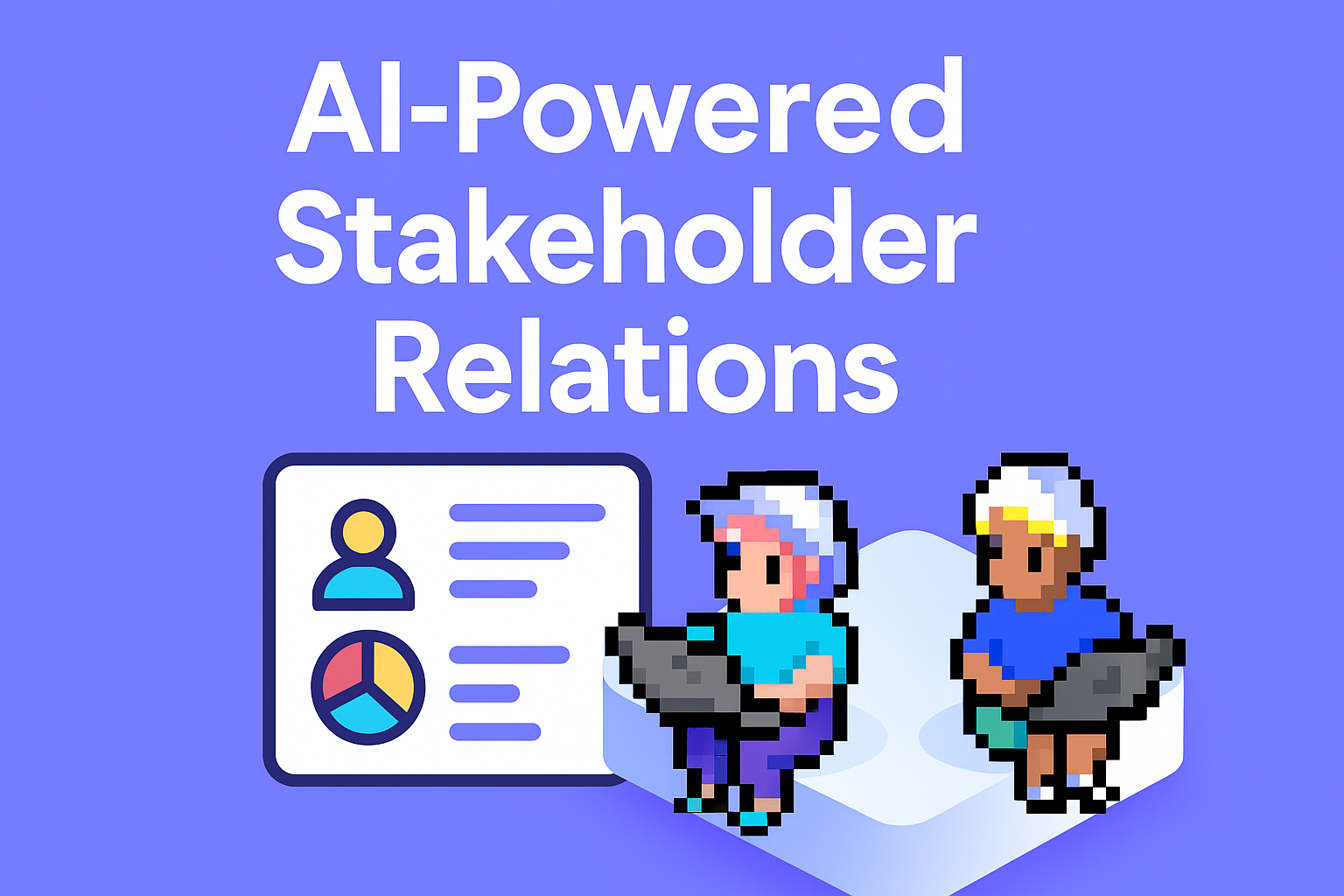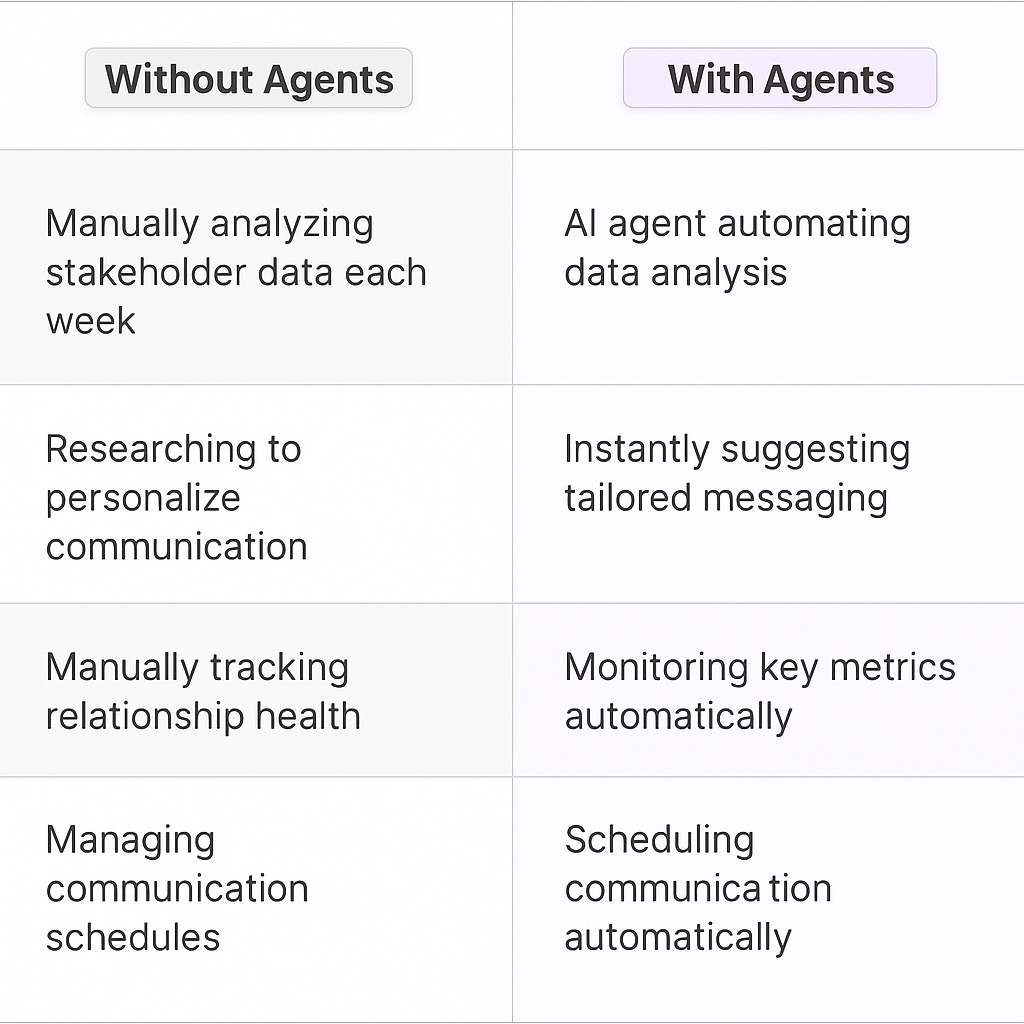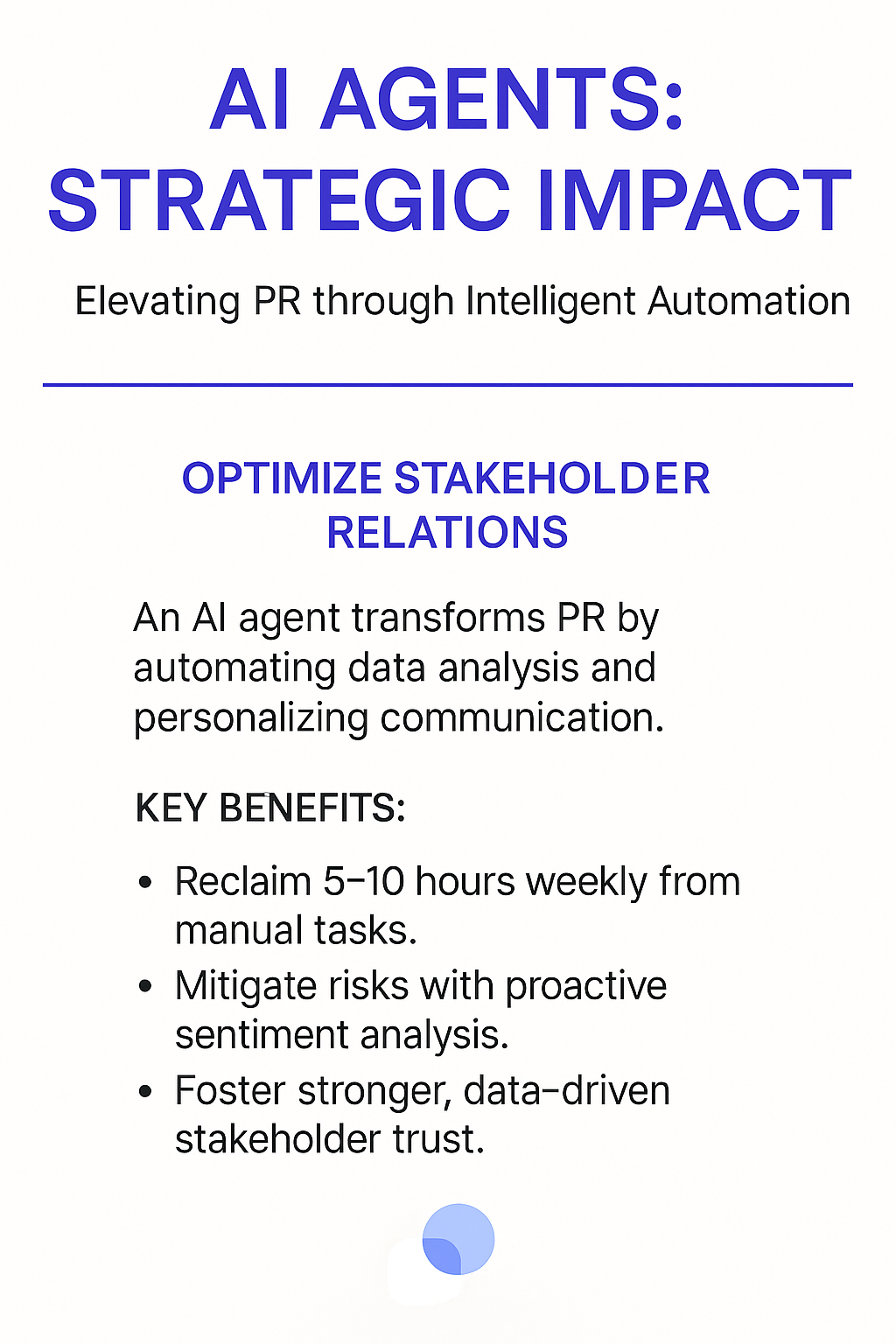
AI-powered stakeholder relations planning agents are revolutionizing how public relations managers manage their stakeholder relationships, coordinate communication, and optimize their engagement strategies. These agents automate the tedious aspects of stakeholder data analysis, communication personalization, and relationship tracking, allowing managers to focus on building strong connections and fostering trust. This technology streamlines workflows, reduces communication gaps, and enhances overall relationship management.
Before Meeting
Your AI agent analyzes stakeholder engagement history, tracks communication preferences, and identifies optimal touchpoint opportunities ahead of the meeting. You walk into the meeting with a clear understanding of stakeholder needs and preferences.
During Meeting
As you discuss stakeholder engagement strategies, your AI agent monitors stakeholder sentiment, maps influence networks, and suggests personalized engagement strategies for different stakeholder groups. This keeps the meeting focused and data-driven.
After Meeting
Post-meeting, your AI agent drafts stakeholder-specific communications, schedules follow-up activities, and tracks relationship health metrics. This helps you stay in control and ensures consistent engagement.
What you’ll need
You don't need to be a developer to set up this integration. Follow this simple guide to get started:
- Meeting Notetaker Agent template
- Calendar account
- Meetings to join
- Relevance AI Account

Who this agent is for
This agent is designed for public relations managers, communication directors, corporate affairs professionals, and anyone involved in planning and coordinating stakeholder relations activities. It's ideal for individuals and teams who frequently engage with internal stakeholders, external clients, community groups, government officials, and other key influencers. Whether you're a small non-profit organization or a large multinational corporation, this agent simplifies stakeholder relations planning and ensures that your engagement efforts are effective and impactful.
How this agent makes stakeholder relations planning easier
Automate stakeholder data analysis
Instead of manually collecting and analyzing stakeholder data, the agent automatically gathers information from various sources, such as CRM systems, social media platforms, and news articles. This saves significant time and provides a comprehensive view of stakeholder sentiment and behavior.
Personalize communication strategies
The agent suggests personalized communication strategies for different stakeholder groups based on their preferences, interests, and concerns. This ensures that your messaging is relevant and resonates with each stakeholder.
Track relationship health metrics
The agent monitors key relationship health metrics, such as engagement frequency, sentiment scores, and feedback ratings. This provides valuable insights into the strength of your stakeholder relationships and helps you identify areas for improvement.
Streamline communication scheduling
The agent automates the scheduling of stakeholder communications, such as emails, phone calls, and meetings. This ensures that you maintain consistent engagement and build strong relationships over time.
Benefits of AI Agents for Public Relations Managers
What would have been used before AI Agents?
Public relations managers traditionally relied on manual methods, such as spreadsheets, databases, and email threads, to manage stakeholder relations. This process was time-consuming, prone to errors, and often resulted in inconsistent engagement. They would spend valuable time collecting data, personalizing communication, and tracking relationship health, taking away from their core responsibilities of building relationships and managing reputation.
What are the benefits of AI Agents?
AI agents offer a streamlined and automated approach to stakeholder relations planning, freeing up public relations managers to focus on more strategic tasks. The most significant benefit is the time saved by automating data analysis, communication personalization, and relationship tracking. The agent handles everything from gathering stakeholder information to scheduling follow-up activities, reducing the administrative burden on the manager.
AI agents also improve communication effectiveness by suggesting personalized messaging and identifying optimal touchpoint opportunities. This ensures that your engagement efforts are targeted and impactful. Furthermore, the agent enhances relationship management by tracking key metrics and providing insights into stakeholder sentiment and behavior.
By integrating with existing CRM systems and communication tools, the agent provides a seamless and user-friendly experience. This eliminates the need for manual data entry and ensures that all stakeholder interactions are accurately recorded and easily accessible. Ultimately, AI agents enhance productivity, reduce stress, and allow public relations managers to focus on building strong relationships and managing reputation effectively.
Traditional vs Agentic meeting planning
Traditionally, public relations managers spent hours each week manually analyzing stakeholder data. Now, AI agents automate this, freeing up time for strategic planning. Before, personalizing communication required extensive research and manual customization. With an agent, personalized messaging is suggested instantly, based on stakeholder preferences. Tracking relationship health used to be a manual task, often neglected. Now, key metrics are monitored automatically, providing valuable insights. Managing communication schedules was a challenge. The agent automates scheduling, ensuring consistent engagement. Finally, manual data entry was prone to errors. The agent syncs seamlessly with existing systems, keeping everything accurate and up-to-date.

Tasks that can be completed by a Stakeholder Relations Planning Agent
Public relations managers juggle numerous tasks, from crafting press releases to managing media inquiries and coordinating events. A stakeholder relations planning agent can handle many of the administrative tasks associated with stakeholder engagement, allowing managers to focus on their core responsibilities.
Analyzing Stakeholder Data
The agent gathers and analyzes stakeholder data from various sources, such as CRM systems, social media platforms, and news articles, providing a comprehensive view of stakeholder sentiment and behavior.
Personalizing Communication Strategies
The agent suggests personalized communication strategies for different stakeholder groups based on their preferences, interests, and concerns, ensuring that your messaging is relevant and resonates with each stakeholder.
Tracking Relationship Health Metrics
The agent monitors key relationship health metrics, such as engagement frequency, sentiment scores, and feedback ratings, providing valuable insights into the strength of your stakeholder relationships.
Scheduling Stakeholder Communications
The agent automates the scheduling of stakeholder communications, such as emails, phone calls, and meetings, ensuring that you maintain consistent engagement and build strong relationships over time.
Drafting Stakeholder-Specific Communications
The agent can draft stakeholder-specific communications, such as newsletters, press releases, and social media posts, tailored to the interests and concerns of each stakeholder group.
Monitoring Stakeholder Sentiment
The agent monitors stakeholder sentiment on social media and other online platforms, alerting you to any potential issues or concerns that need to be addressed.
Mapping Influence Networks
The agent maps influence networks among stakeholders, identifying key influencers and potential advocates for your organization.
Generating Relationship Health Reports
The agent generates relationship health reports that provide a comprehensive overview of your stakeholder relationships, highlighting areas of strength and areas for improvement.

Things to Keep in Mind When Building a Stakeholder Relations Planning Agent
Building an effective stakeholder relations planning agent requires careful planning and attention to detail. The goal is to create an agent that seamlessly integrates with your existing workflows and provides a user-friendly experience for all participants.
Define Clear Objectives
Before you start building your agent, define clear objectives for what you want it to achieve. Do you want to improve stakeholder engagement, enhance communication effectiveness, or strengthen relationships? Having clear objectives will help you prioritize features and measure success.
Integrate with Existing Systems
Ensure that your agent integrates seamlessly with existing CRM systems, communication tools, and social media platforms. This will make it easier for users to adopt the agent and incorporate it into their daily routines.
Prioritize User Experience
Make sure that the agent is easy to use and intuitive. The interface should be clean and uncluttered, and the stakeholder relations planning process should be straightforward and efficient.
Automate Data Analysis and Reporting
Configure the agent to automatically analyze stakeholder data and generate reports on relationship health. This will save time and provide valuable insights into your stakeholder relationships.
Personalize Communication Strategies
Allow users to customize communication strategies for different stakeholder groups based on their preferences, interests, and concerns. This will ensure that your messaging is relevant and resonates with each stakeholder.
Handle Data Privacy and Security
Ensure that the agent complies with all relevant data privacy and security regulations. This is especially important when dealing with sensitive stakeholder information.
Test Thoroughly
Before you roll out the agent to your entire team, test it thoroughly to ensure that it is working correctly and that it meets your objectives. Gather feedback from users and make any necessary adjustments.
Continuously Improve
Once your agent is live, continue to monitor its performance and gather feedback from users. Use this information to identify areas for improvement and make ongoing enhancements.
The Future of AI Agents in Stakeholder Relations Planning
The future of AI agents in stakeholder relations planning is bright, with advancements in natural language processing, machine learning, and artificial intelligence promising to further streamline and enhance the stakeholder engagement process. Future agents will be able to understand complex stakeholder relationships, anticipate potential conflicts, and proactively suggest solutions.
AI agents will also become more personalized, learning individual stakeholder preferences and tailoring their recommendations accordingly. They will be able to identify preferred communication channels, preferred topics of discussion, and even preferred meeting times, creating a more seamless and user-friendly experience.
Furthermore, AI agents will play a larger role in facilitating collaboration and communication during stakeholder meetings. They will be able to transcribe meeting minutes, track action items, and even provide real-time translation services, making meetings more productive and inclusive.
AI agents will also integrate with other business applications, such as project management tools and CRM systems, providing a holistic view of stakeholder-related activities and enabling better decision-making.
Ultimately, the future of AI agents in stakeholder relations planning is about creating intelligent systems that not only automate the planning process but also enhance collaboration, improve communication, and drive better stakeholder outcomes.









